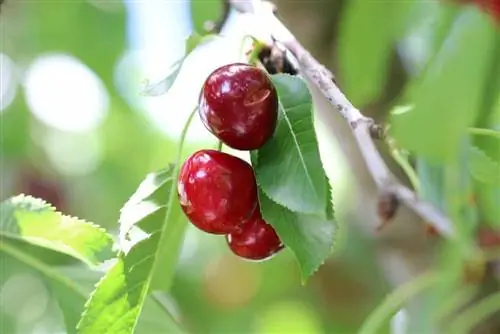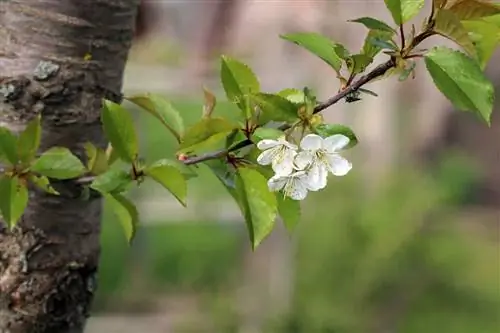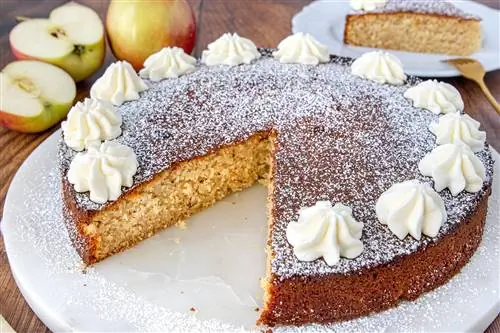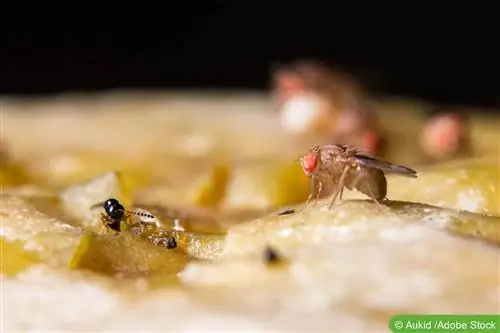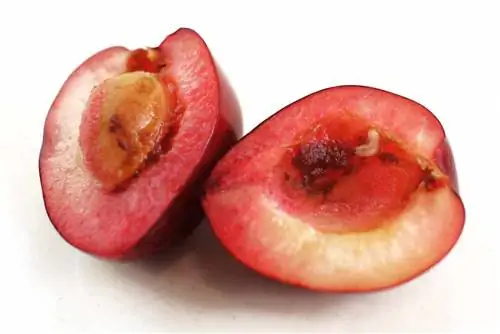- Author admin [email protected].
- Public 2023-12-17 03:39.
- Last modified 2025-01-24 12:45.
Whether hot cherries on waffles, as a cake filling or on rice pudding, simply pouring cherries out of the glass does not serve the purpose of fruity refinement. To do this, cherries need to be thickened. There are various options available for thickening cherries. With the professional instructions you can do it in no time.
Basic
These things apply to all techniques that can be used to thicken cherries:
Heating
No matter which variant you choose to thicken cherries, the cherries must always be heated. Caution must be exercised. If the liquid has thickened, it will burn quickly. It is important to ensure that you stir constantly after thickening and while simmering. Once burned, a very unpleasant taste spreads throughout the entire mixture. There's usually nothing left to save here, so they're just enough for the trash can.
Cherries suitable for thickening
In general, any type of cherry from sweet to sour can be used for thickening. Heart cherries, for example, are a very juicy variety, while cartilaginous cherries have very firm fleshy properties. Whether the cherries are frozen, fresh or from a jar is irrelevant. However, freshly harvested cherries are the crunchier ones. If done correctly, they usually retain significantly more “bite”.
Cherries in a jar have the advantage that they come with the right liquid that is needed for thickening. Frozen cherries usually break down in structure and are then very soft and can even become mushy if they take too long to thaw. For this reason, cherries from the freezer should always be used quickly and are less suitable for the sauce on waffles. As a fruit topping on a cake base or similar. However, they are ideal for use as a cake layer.
Decoring
Before you can start thickening, the pits must be removed from the cherries. If they remained in the cherries, they would have a disruptive effect. In addition, they can detach from the inside of the cherry when boiling and spread throughout the thickened mass, which hinders unrestricted consumption.
Thicken with liquid
In all variations of thickening cherries, the addition of liquid is one of the main ingredients. The fruity aroma is emphasized when you use kirsch. Cherries from the jar already contain this and should be collected when the cherries are removed for later use. If you want to thicken fresh cherries, the easiest option is to use normal commercial cherry juice as a liquid. You can also press or mix some cherries and make your own kirsch this way.
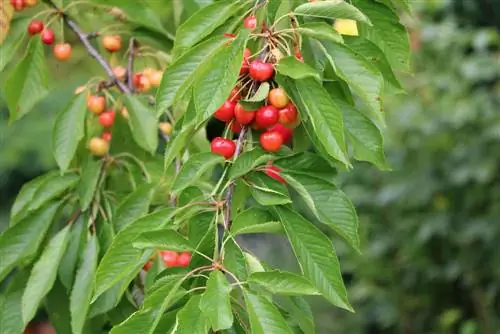
Alternatively, conventional tap water can be used. However, this is tasteless and should only be chosen if other flavor nuances are added as a flavoring additive or via the type of thickening. Otherwise the thickened cherry mixture would taste too bland.
Thickening cherries
We show you the different ways you can thicken cherries:
Classic variant
It is probably the oldest recipe for thickening cherries - with cornstarch. This was previously and can still be used today as potato or corn starch. The more starch you add, the thicker the kirsch will be. The danger here is that too much cornstarch is difficult to extend again. This means that once it is quite solid, it will quickly lump together when liquid is poured into the hot pot. But even when mixing, you need to stir constantly and evenly so that no lumps form. It is recommended that you only stir small amounts of cornstarch into cold liquid. Many recipes describe exactly how many tablespoons of cornstarch are required. Two tablespoons of cornstarch per cherry jar are usually sufficient.
If the consistency turns out to be too thick while heating, stir a small amount of starch into significantly more cold liquid and then mix it into the heated amount. In this way you “extend” the sauce while avoiding the formation of lumps.
How to thicken cherries with cornstarch:
- For softened cherries: put 350 grams of cherries (drained weight for glasses) in a pot with 1/2 liter of water/cherry juice
- Heating the pot
- For whole cherries: first thicken the liquid and finally fold in the cherries and heat briefly
- Stir about two tablespoons of cornstarch into a little water/cherry juice
- For a firmer consistency, there should be around three to four tablespoons of cornstarch (for example for cake fillings)
- Slowly pour the mixture into the pot while stirring evenly and mix with the water/cherry juice
- Bring to a boil
- If the consistency is not as desired, repeat the process with more or less cornstarch and add
- Once you have reached the desired consistency, remove the pot from the heat
- Serve/process hot or place in the fridge to cool
Thickening with vanilla or cream pudding powder
First: Vanilla pudding used to thicken does not give the whole thing a noticeable vanilla note. In this case, the pudding powder is primarily used to firm the consistency. If a vanilla flavor is desired, this must be added in another form. The advantage of this thickening variant is that the consistency is always similar to a pudding. You can't add too much or too little here, as long as you stick to the correct amount of liquid.
How to thicken with vanilla pudding:
- Heat 1/2 liter of cherry juice/water (with or without cherries - with the latter, the cherries are folded in after thickening so that they remain whole)
- Mix a packet of pudding powder with a little cold liquid
- Slowly pour into the heated (cherry) water and stir continuously
- Bring the mixture to the boil while stirring constantly
- If necessary, add cherries and warm briefly
Tip:
Since kirsch from a cherry glass is usually not enough, you can mix it with water or conventional cherry juice to make 0.5 liters of liquid. Milk is not suitable.
Thickening with gelling agents
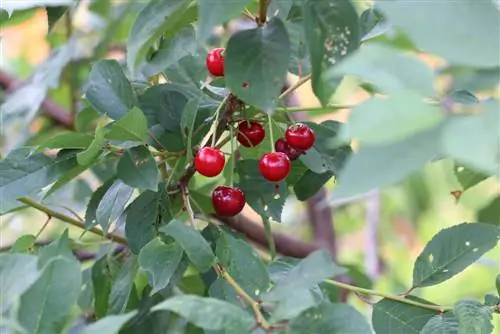
If you want a fairly solid mass of hot cherries to spread on a cake, for example, then thickening with gelling agents is best. These ensure that the thickened liquid does not run and flow down the edges of the cake, for example. This is due to their ability to bind liquid.
The most common gelling agents include:
- Cake icing
- Gelatin
- Carob bean gum (suitable for vegans)
- Agar-agar (vegan gelling agent made from dried seaweed)
How to thicken with gelatin and cake icing:
- Stir a pack of gelatine or cake icing into approximately 250 milliliters of warmed (cherry) water
- Let it boil briefly
- If you want the cherries to stay whole, add them to the pot just before they boil - otherwise start with the liquid
- Remove from heat and process immediately while warm
How to thicken with carob bean gum and agro-agricultural powder:
- Stir in one gram of carob bean gum per hundred milliliters of cold (cherry) water
- Alternatively, stir a teaspoon of finished agar-agar powder into 250 milliliters of cold liquid
- Cherries can be added before stirring or before boiling
- Let it boil briefly
- Ready for immediate use on cakes or similar
Thickened cherries with more flavor
Depending on what use you intend for the thickened cherries, you can give them different flavors. If you like it sweet, you can add sugar before boiling. Children especially like cinnamon, which also provides a wintery aroma at Christmas time.
Hot cherries get a fresh note with a dash of lemon juice. Rum or red wine can provide a special taste, especially for cakes and tarts. An almond liqueur can also be mixed in for a light nutty note, while a little orange liqueur in thickened cherries underlines the fruity aroma.

